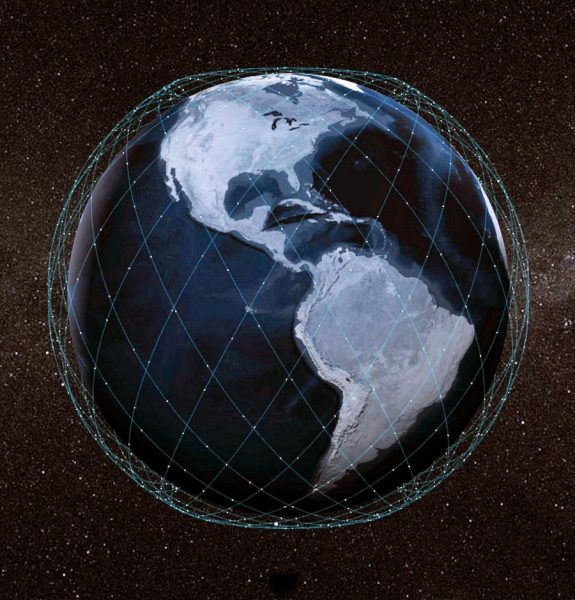Starlink Lose 100 LEO Broadband Satellites Due to Design Flaw

SpaceX has announced that they will have to de-orbit (scrap) around a hundred of their older “early-version 1” Starlink ultrafast low-latency broadband satellites in Low Earth Orbit (LEO) because of a design flaw, which might otherwise cause the space platforms to fail in orbit and become non-manoeuvrable.
The operator’s constellation currently has around 5,438 LEO satellites in orbit around the Earth (altitude of below 600km) and they’re in the process of adding thousands more by the end of 2027. Customers in the UK pay from £75 a month, plus £449 for the home kit (standard dish, router etc.) and £20 for shipping on the ‘Standard’ package, which promises fast internet latency times of 25-50ms, downloads of c. 25-100Mbps and uploads of c. 5-10Mbps.
The satellites are actually designed to deorbit naturally if they fail (i.e. they get pulled down by the earth’s gravity and atmospheric drag), but that approach can take around 5 years and also raises the danger (risk of collisions etc.) for other space users. Instead, SpaceX proactively deorbits satellites that are identified to be at an elevated risk of becoming non-manoeuvrable.
Advertisement
SpaceX has to-date initiated controlled deorbits on 406 satellites out of the nearly 6,000 launched. Of those, 17 are currently non-manoeuvrable, passively decaying, but closely tracked to help mitigate collision risk with other active satellites. The other 95% of satellites the Starlink team initiated controlled descent for have already de-orbited.
In this case, SpaceX has identified a design flaw with a small group of their earliest satellites, which could prevent their ability to manoeuvre. Rather than risk that outcome, the company has instead opted for a controlled de-orbit that will take about six months to gradually bring the group down toward their inevitably firing death.
Starlink’s Statement
“These satellites are currently maneuverable and serving users effectively, but the Starlink team identified a common issue in this small population of satellites that could increase the probability of failure in the future. The satellites will follow a safe, circular, and controlled lowering operation that should take approximately six months for most of the vehicles. Controlled, propulsive deorbit is much shorter and safer than a comparable ballistic deorbit from an equivalent altitude. All satellites will maintain maneuverability and collision avoidance capabilities during the descent. Additionally, these deorbiting satellites will take maneuver responsibility for any high-risk conjunctions consistent with space safety and sustainability best practices.
As we lower and deorbit our satellites, SpaceX will continue to share high-fidelity future position and uncertainty prediction information, multiple times a day, with other operators and launch providers. Accurately knowing where every satellite is and will be in orbit is critical to space sustainability. SpaceX encourages all satellite operators to proactively publish information on their satellites’ future positions and uncertainties, as quickly as possible after orbital insertion, including pre-launch information for which orbits the satellites will be deployed into and throughout their service lifetime.
While this proactive approach comes at the cost of losing satellites that are serving users effectively, we believe it is the right thing to do to keep space safe and sustainable—SpaceX encourages all satellite owners and operators to safely de-orbit satellites before they become non-manoeuvrable. Just as importantly, even as we lower and de-orbit satellites, Starlink’s customer experience will not be impacted. SpaceX has the capacity to build up to 55 satellites per week and launch more than 200 satellites per month, which allows us to continually improve our system and make it more resilient, while increasing access to high-speed, low-latency internet for more people all around the world.”
Admittedly, a design flaw that affects 100 satellites is going to be a painful multi-million-pound hit for the company, albeit not one that will be enough to appreciably impact Starlink’s service quality (they’re adding more than this every month or so). Credits to The Wee Bear (regular reader) for spotting this update.
Mark is a professional technology writer, IT consultant and computer engineer from Dorset (England), he also founded ISPreview in 1999 and enjoys analysing the latest telecoms and broadband developments. Find me on X (Twitter), Mastodon, Facebook, BlueSky, Threads.net and Linkedin.
« Broadband, TV and Mobile Price Hikes Set for Virgin Media O2 UK UPDATE
F&W Networks Grows UK Full Fibre Cover to 410,000 Premises »






















































What a shame, it is a pity more of them don’t have the problem.
Why?
I have no fibre, 5G and the 4g reception is poor. Our copper connection is slow and continuously fails. Starlink gives us what we need, thank goodness. I may not agree with everything that Musk says, but the system works and I am thankful for the service provided.
@Saddler, yes I realise it can be useful for people who can’t get broadband any other way, just a shame it is owned by Musk, but then if not Musk, no doubt by some other person like him, these millionaires/billionaires all seem to be the same, Must be money that makes them like they are. If that is the case, I prefer not to have millions
Where did spaceman touch you
Just to address the negative comment here – As a rural UK’er with no sign of Fibre, Starlink for me was a godsend. 4G options were terrible, landline was working intermittently.
Getting those first few speed tests at 150+ mbps was amazing.
Doing a days work from home, and being on teams calls for 4+ hours of those without a hiccup was a game changer – up until starlink became viable I was considering getting a telecoms guy in to see what kind of mast + 4g antenna they could install (and even that would have been poor compared to starlinks offering).
Since then BT have sorted out the landline, and I’ve been able to retire my starlink kit – I got an email from Starlink this week offering me £200 to return for the kit I bought, I only paid £99 for it – i’d rather keep it though, never know when I might have landline issues again.
I know a lot of people like to be negative about it probably due to the owner, but for those of us in rural areas with rubbish options it’s quite literally revolutionary.
Agreed. It’s a great product besides the ceo. A friend went from 1mbit ADSL with no alternative to 150mbit overnight.
Although Oneweb need to pull their finger out and sort their alternative. We may see the price fall a fair bit.